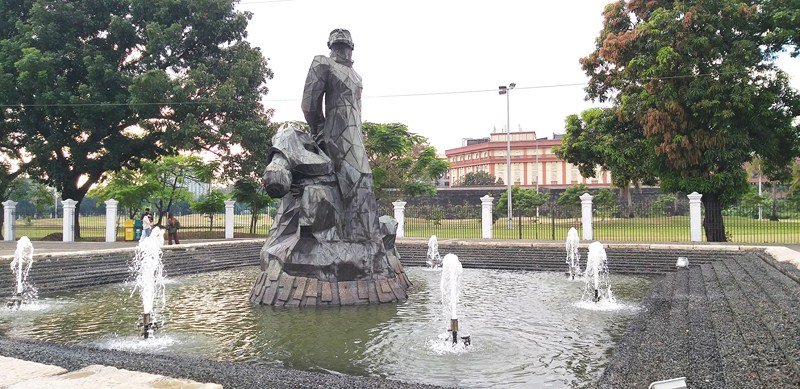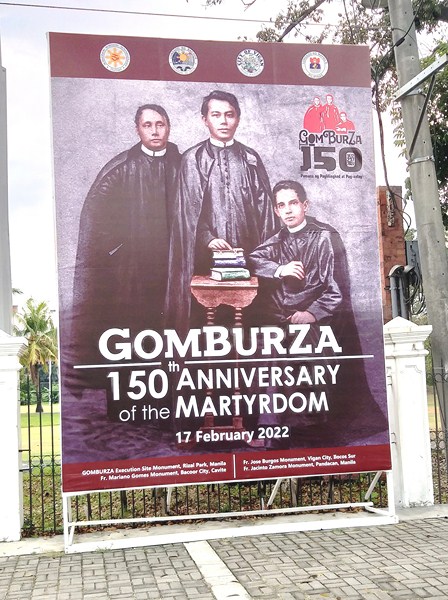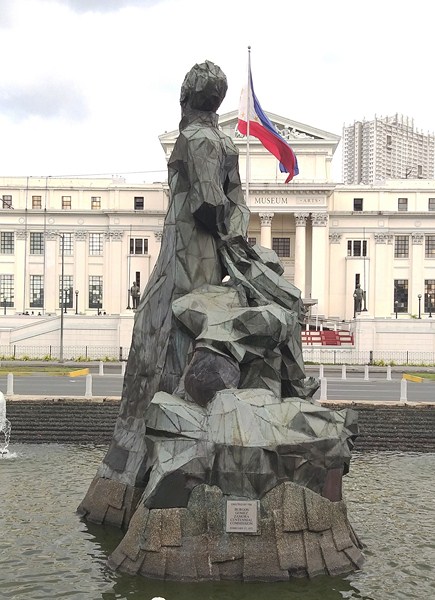The day Jandy and I revisited the National Museum of Fine Arts just so happened to be the 150th anniversary of the martyrdom, by garrote, of the Filipino priests Fr. Fr. Mariano Gomez, Fr. Jose Burgos and Fr. Jacinto Zamora, collectively known as Gomburza. After our visit to the museum (to be continued on another day due to lack of time), we crossed Padre Burgos Ave. (named after one of the priests) to visit the Gomburza Monument. The commemoration ceremony had already ended and what remained were the memorial wreaths that were laid.
Check out “National Museum of Fine Arts”
In a system that favored and Spanish friars lopsidedly over locals, the three secular (diocesan) priests fought for equal treatment among priests. After the failed January 20, 1872 Cavite Mutiny (uprising of around 200 Filipino military personnel of Fort San Felipe, the Spanish arsenal in Cavite), the Spanish colonial authorities sentenced three priest on false charges of of treason, sedition, and subversion on February 15. Two days later, they were executed by garrote in Luneta. Their brutal deaths by garrote lit the flame of nationalism. National Hero José Rizal dedicated El filibusterismo, his second novel, to the three martyrs. His two novels inspired the Philippine Revolution of 1896 leading to the declaration of independence on June 12, 1898.
Across the street, set elegantly against the green field and historic walls of Intramuros, is a low fountain, at the center of which is the stunning and massive bronze sculpture, by Modernist sculptor Solomon Saprid (1917 – 2003), of the three heroes. The statue, commissioned in the 1970s to honor the three martyr priests, was originally located at Plaza Roma, in front of the Manila Cathedral, where it was inaugurated by then President Ferdinand Marcos on January 17, 1972.
Check out “Manila Cathedral”
A major figure in the visual arts, especially in sculpture, Saprid’s significant works can be found in some of the world’s most important institutions such as the 25 ft. long, 15 ft. wide and 9 ft. high “ASEAN Birds” in Chatunchak Park in Bangkok, a 5 ft. x 50 ft. mural in Hong Kong & Shanghai Banking Corporation Building, the “Bull Cancer” fountain at the Triumph International in Germany, the “Statue of Christ” at the Indiana University Museum, and “Mother and Child,” a copper statue for the 1st Australian Biennale in Sydney presently in the collection of Westinghouse in Philadelphia to name a few.
In 1981, the sculpture was moved to its present location by the Intramuros Administration (IA). Soon, however, urban decline set in and the sculpture was vandalized, the pool was used for bathing and washing clothes, and the entire area became a hangout for the homeless, the ambulant vendor, and the occasional street drunk.
In 2017, upon clarification of the jurisdiction of the area, the Intramuros Administration reasserted it ownership over the area and, partnering with the National Museum of the Philippines, undertook a restoration project that would not only clean and improve the site for pedestrians, but also to give three national heroes, a stunning sculpture and its artist the honor and respect they deserve.
On August 2018, with a modest budget of P15 million, the herculean effort to improve the monument was launched to remove all the distractions to highlight Solomon Saprid’s Gomburza. Architect Jose Ramon Faustmann prepared the move by constructing a 20 x 20 m. pool where the sculpture would arise from the center. The project was completed just before the pandemic began and the lockdown declared in 2020.
On February 17, 2021, Saprid’s Gomburza was included in the elite list of National Monuments (only the seventh to be given that honor) by the National Historical Commission of the Philippines.
As part of the commemoration of the 150th year of the martyrdom of Frs. Gomez, Burgos, and Zamora, wreaths were laid, a historical marker was unveiled, and its new designation as a National Monument was announced. Today, the expanse of the plaza, with its simple and clean design, is a safe and well-illuminated space to walk on. This outstanding landmark of Modernist Philippine art is also the perfect position to appreciate the Spanish-era fortification of Intramuros and the Neo-Classical architecture of the impressively restored National Museum of Fine Arts.
Gomburza Monument: Liwasang Gomburza, Padre Burgos Ave., Ermita, Manila 1002






